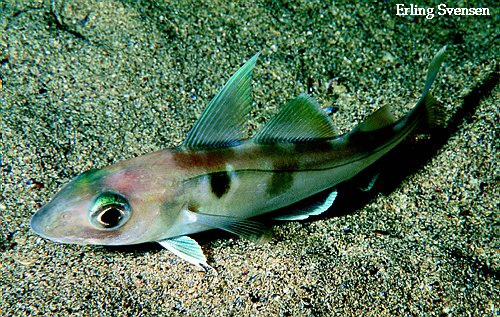Identification:
Classic codfish profile with 3 dorsal and 2 anal fins. The anterior ray of
the first dorsal fin is long, giving the fin a high and pointed profile,
whilst the other dorsal and anal fins are rounded. The small pelvic fins,
with their extended first rays, are positioned on the throat, and closer
to the snout, than the pectoral fins. The tail fin is concaved. The head
is reduced and has large eyes. The lower jaw has a small chin barbel, and
is shorter than the upper jaw. The angle of the jaw occurs before the eye.
The back tends to exhibit a dark greenish brown colouration, that pales at
the sides, and towards the white of the belly. The lateral line is dark to
black, and a characteristic blackened thumb mark occurs above and behind
the pectoral fin base, and straddles the lateral line.
Breeding:
Spawns between February to June (peak between March to April).
Tends to favour deeper water than cod, and thus the main spawning grounds
around the UK, include those to be found east of The Shetland Isles, north
of the Outer Hebrides, and around the Faroes.Migration to the spawning grounds
in Winter, is then followed by the fish returning to shallow waters to form
feeding shoals.
The eggs take 14 to 20 days to hatch, and the young Haddock remain in the
surface to mid-waters, until they reach about 5cm in length. They then move
towards the bottom, to start their demersal existence. Most Haddock reach
maturity during their third year. Growth rates vary depending upon location
(south faster than north), with 30 to 45cm in total length for a 4 to 5 year
old being about average.
Habitat:
Found close to the sea floor, often in schools, usually at depths of between
40 to 300m
Food:
Young pelagic fish feed mainly on copepods, whilst the larger demersal fish
feed on a variety of crustacea, molluscs, annelids and echinoderms, with
the occasional small fish such as sandeels.
Range:
Found throughout the waters of the UK, but tending
towards the Northern extent, especially the North
Sea.
Additional Notes:
Commercially important fish, who's stocks have been hit by overfishing. Good
eating. |
